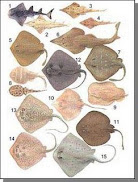
Poppers are a fun way of catching both bass and bluefish. Everyone likes to see a fish come to the top and smash a surface popper to oblivion. It’s heart stopping and it gets your adrenaline pumping.
When most people fish poppers for stripers, they fish them too fast. Having the lure moving slowly and popping will result in a lot more hits than racing it across the top of the water. The faster you move the plug the more bluefish you will attract and the few stripers you will catch.
Some poppers are built to sink, some are built to float and still others will even swim on the surface when reeled in very slowly between pops and splashes. Using or choosing the right one for certain conditions plays a big role in just how many fish you will catch.
Poppers that sink are normally heavier than others of the same type, and thus cast a lot farther than ones of similar size and shape. I like these for beach fishing where distance is sometimes very important. On beaches where there are outer bars, rock piles or rips, it’s often necessary to be able to make a very long cast to reach where the fish are.
Sinking poppers normally requires a rod that is a bit stiffer and longer to get it up on the surface and keep it there so it works properly.
Floating poppers are good in a variety of situations and conditions. In areas where there are lots of rocks and little water depth, such as at the bottom have tide. Floating poppers will come over them and through them better with much less chance of hanging up.
When the wind is calm or there is just a slight ripple on the water surface, floating poppers can bring some explosive strikes. Fish these conditions early in the morning before the sun comes up or late in the evening as it goes down. Being able to keep the lure on the surface and in front of the fish’s face helps immensely when trying to lure him to the surface.
With technology being what it is today, poppers now come with rattles built-in to add sound besides the pops, splashes and gurgles. There are numerous times that rattles can and will make all the difference in the world.
When tying on a popper use a good quality snap swivel like a Duo-Lok, which allows the lure to move as it was designed to do. Attaching a split ring to the front eye will also help in making it work better.
Loop knots are also good to use when fishing poppers. Fly fishermen use loop knots all the time. They are easy to tie and have very good holding strength on almost any mono leader when tied properly. A good knot book will illustrate how to tie one properly. It’s’not at all hard to do.
When fishing for bluefish, remove all the trebles and use one single Siwash Salmon hook on the tail end. Since most blues will attack from the rear first, the big salmon hook usually gets them. It’s a lot easier to deal with a blue with one hook than it is with two or three sets of trebles. It’s also a lot less painful; having been stuck a few times myself. When you take off thousands of fish in the coarse of a season you raise the odds tremendously of getting stuck sooner or later. I also crush the barbs so if you do get stuck it comes out easier than it went in.
If you learn to play and fight the fish properly, you won’t loose any more fish than ones with barbs won’t. In fact, you wind up hooking more since it penetrates much more easily in a boney jaw. Just make sure you keep your hook razor sharp.
For stripers, I’ll put a single salmon hook in the front in place of the treble. Most bass will take the plug headfirst so you need a sharp hook up front. You can dress the tail hook with feathers, bucktail or whatever you like for stripers, but I leave the hook bare most times for bluefish. If you do dress the tail hook for blues, use something synthetic like Ultra hair. It will last longer and be sure to dress it sparsely.
















